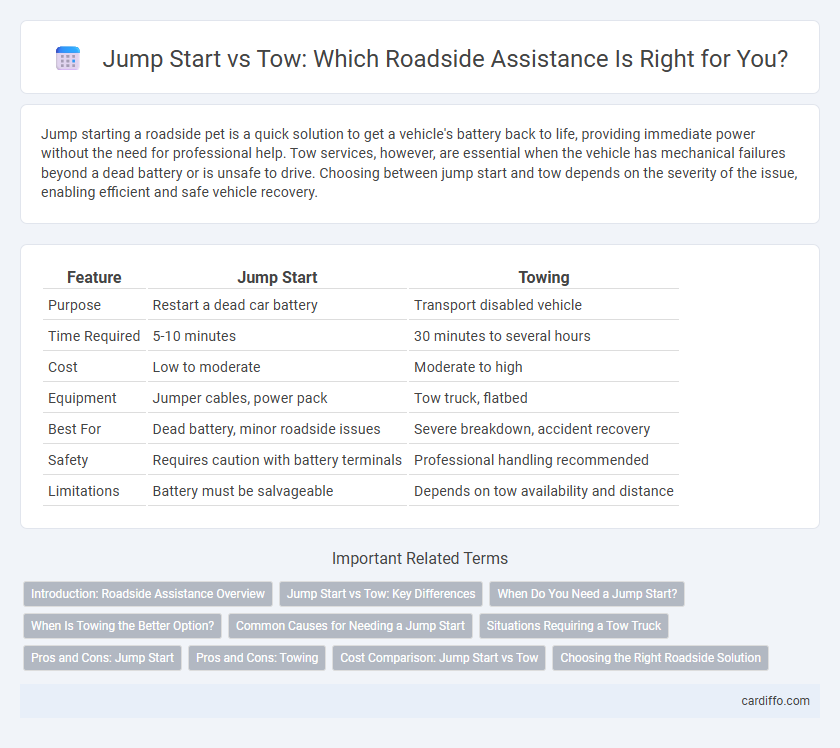Jump starting a roadside pet is a quick solution to get a vehicle's battery back to life, providing immediate power without the need for professional help. Tow services, however, are essential when the vehicle has mechanical failures beyond a dead battery or is unsafe to drive. Choosing between jump start and tow depends on the severity of the issue, enabling efficient and safe vehicle recovery.
Table of Comparison
| Feature | Jump Start | Towing |
|---|---|---|
| Purpose | Restart a dead car battery | Transport disabled vehicle |
| Time Required | 5-10 minutes | 30 minutes to several hours |
| Cost | Low to moderate | Moderate to high |
| Equipment | Jumper cables, power pack | Tow truck, flatbed |
| Best For | Dead battery, minor roadside issues | Severe breakdown, accident recovery |
| Safety | Requires caution with battery terminals | Professional handling recommended |
| Limitations | Battery must be salvageable | Depends on tow availability and distance |
Introduction: Roadside Assistance Overview
Roadside assistance offers crucial services such as jump starts and towing to help drivers in emergencies. Jump starting a vehicle restores battery power quickly on-site, making it a faster and often more cost-effective solution than towing. Towing becomes necessary when mechanical failures or accident damage prevent immediate vehicle operation, ensuring safe transport to a repair facility.
Jump Start vs Tow: Key Differences
Jump start involves using electrical power from another vehicle's battery to quickly revive a dead battery, making it a fast and cost-effective roadside assistance solution. Tow services, by contrast, physically transport a disabled vehicle to a repair shop or safe location, often necessary when the car has engine failure or is unsafe to drive. The choice depends on the vehicle's condition; jump starting is ideal for battery-related issues, while towing handles more serious breakdowns requiring comprehensive repairs.
When Do You Need a Jump Start?
A jump start is needed when a vehicle's battery is dead but the engine and starter motor remain functional, typically caused by leaving lights on or cold weather. It quickly restores power to the battery, allowing the engine to start without the cost and time of a tow. If electrical components fail or the battery cannot hold a charge, towing to a mechanic may be necessary for a battery replacement or further diagnostics.
When Is Towing the Better Option?
Towing becomes the better option when a vehicle suffers from severe mechanical failures such as transmission issues, engine problems, or extensive damage after an accident. Jump starting only addresses battery-related issues and cannot resolve internal vehicle malfunctions that prevent safe operation. Professional towing ensures the vehicle reaches a repair facility without causing further damage or risking roadside safety.
Common Causes for Needing a Jump Start
Common causes for needing a jump start include a dead or weak battery, leaving lights on overnight, and extreme weather conditions such as cold winters that drain battery power. Faulty alternators and corroded battery terminals also frequently lead to insufficient electrical charge, preventing the vehicle from starting. Recognizing these issues helps determine when a jump start is a practical solution compared to calling a tow truck.
Situations Requiring a Tow Truck
A tow truck is necessary when a vehicle encounters severe mechanical failure, such as transmission problems or a dead engine, that cannot be resolved with a jump start. Situations involving accident damage, flat tires without a spare, or unsafe driving conditions also require professional towing services for safe vehicle transport. Jump starts are limited to battery-related issues, while towing ensures the vehicle reaches repair facilities intact under more serious circumstances.
Pros and Cons: Jump Start
Jump starting a vehicle offers the advantage of immediate power restoration without the need for professional assistance, making it a quick and cost-effective solution for dead batteries. However, jump starts pose risks such as potential damage to the electrical system if cables are incorrectly connected or if the battery is severely drained or faulty. Unlike towing, jump starting is limited to battery issues and cannot address mechanical failures or vehicle immobilization due to other factors.
Pros and Cons: Towing
Towing provides a reliable solution for vehicles that cannot be jump-started due to severe battery issues or mechanical failures, ensuring safe transport to repair facilities without risking further damage. However, towing can be costly and time-consuming, especially over long distances, and may require specialized equipment for certain vehicles, increasing the overall expense. Unlike jump starting, towing eliminates the risk of electrical system damage but can cause wear on tow vehicles and requires professional handling for secure and legal transportation.
Cost Comparison: Jump Start vs Tow
Jump starting a vehicle typically costs between $50 and $100, offering an affordable solution to battery-related issues compared to towing, which can range from $75 to $200 or more depending on distance and service provider. Tow services incur higher expenses due to labor, equipment, and mileage, making jump starts a cost-effective option when the problem is battery-related. Selecting a jump start over a tow can save at least 30-50% on roadside assistance expenses in most urban areas.
Choosing the Right Roadside Solution
Selecting the right roadside solution depends on the vehicle's condition and urgency. A jump start is ideal for battery-related issues, providing a quick restore of power without towing. Towing becomes necessary when mechanical failures or safety concerns prevent the vehicle from being driven safely to a repair shop.
Jump start vs tow Infographic

 cardiffo.com
cardiffo.com